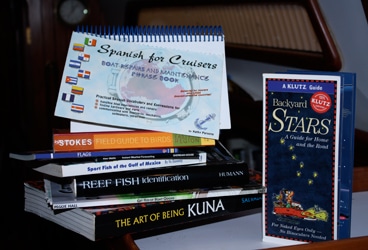
Onboard Library
The Reef Set: Reef Fish, Reef Creature, and Reef Coral Identification by Ned Deloach and Paul Humann (New World Publications). Fish-identification books are a dime a dozen, and we had several aboard. Unfortunately, every time I discovered something new, it seemed that I’d rarely find what I was looking for in a book—until I bought this trilogy. It’s designed in a way that makes it easy to identify the fish, and it includes color photos and details related to each one, including habitat and behavior. Because we love snorkeling, this set wins, hands down.
Stokes Field Guide to Birds: Eastern Region by Donald and Lillian Stokes (1996; Little, Brown and Company). When the first frigate bird soars above your boat or a brown booby lands on your wind generator, you’ll wish you had a bird book aboard. We prefer books with full color photos and information about habitat and range all in one place, and this one fills that bill.
An Illustrated Field Guide to the Birds of Panama by Ernesto Ponce and Giselle Muschett (2006; Ediciones Balboa). Easily available throughout Panama, this work describes birds native to that country.
Usborne Spotter’s Guides: Flags of the World by William Crampton (2003; Usborne Books). Before leaving U.S. waters, we rarely had the opportunity to puzzle over the national identity of boats in the anchorage. Now we consult our flag book daily to identify neighbors in our anchorages.
Sport Fish of the Gulf of Mexico by Vic Dunaway (2000; Wickstrom Publications). The first time that our new trolling rod sang, we reeled in a two-foot-long fish—but was this fish edible? Dunaway’s full-color photo of the Spanish mackerel made identification easy, and the Food Value section in the description let us know that dinner, indeed, was on our hook.
Weather, An Introduction to Clouds, Storms, and Weather Patterns (2001; Waterford Press) and Instant Weather Forecasting by Alan Watts ($13; 4th ed., 2011; Adlard Coles Nautical) help answer questions about clouds overhead or triple rainbows, among others. The format of Instant Weather Forecasting juxtaposes a full-page photo of a cloud with a chart listing the weather trends and timing associated with that cloud, including wind, visibility, precipitation, temperature, and barometric pressure.
Weather Predicting Simplified by Michael Carr (1999; International Marine). This is the best reference manual for weatherfaxes, surface-analysis charts, and wind/wave charts. Written by a licensed captain who’s also been a professional weather router for world voyagers, it’s useful for understanding weather forecasts, identifying unrecognized symbols on surface-analysis and wind/wave charts, and providing basic information necessary for learning to predict weather.
Backyard Stars: a Guide for Home and the Road (1998; Klutz). This book answers such general questions as “What is that bright star?” Skies in the tropics are so dazzling that you’ll want to know where and when to spot planets, stars, meteor showers, and comets so you can relax on deck and take in the heavenly show.
S_panish for Cruisers: The Boater’s Complete Language Guide for Spanish-Speaking Destinations_ by Kathy Parsons (2nd ed., 2008; Aventuras Publishing Company). Parsons not only provides the words and easy pronunciations but also accompanying pictures. If all else fails and no one understands your Spanish, you can simply point at what you need!
A Boat Owner’s Guide to Marine Sanitation Systems and Other Sources of Aggravation and Odor by Peggie Hall (2003; Seaworthy Publications). If the bilge perfume won’t go away, if you need a new head and don’t know which to buy, or if you don’t know when to replace your sanitation hoses, then this book is for you. We don’t need to refer to it as often as we refer to the others, but when it’s necessary, it instantly becomes the most important book aboard!
WEB EXTRA
Even before buying Winterlude, our 1985 Passport 37, our bookshelves were full of books with titles like_ Marine Diesel Engines_ by Nigel Calder;_ Boatowner’s Illustrated Handbook of Wiring_ by Charlie Wing; and_ Heavy Weather Sailing_ by K. Adlard Coles.
But all liveaboard wanderers need cruising-specific information, too. Of course this includes cruising guides and paper charts, but also books specific to your cruising area. Cruising the U.S. East Coast, we had several guides, and enjoyed Claiborne Young’s cruising guides (various publishers, available at Amazon for $18-$26) for the extra information included—history, geography, and attractions. While in Panama, we enjoyed The Path Between the Seas**, the Creation of the Panama Canal, 1870-1914**, by David McCullough;_ The Art of Being Kuna_ by Mari Lyn Salvador;** A People Who Would Not Kneel: Panama, the United States and the San Blas Kuna** by James Howe.
Also, don’t forget regular travel guides for inland travel. Try the Lonely Planet Shoestring Guides for travel information, the Insight Guides for area information and other Lonely Planet guides, such as Watching Wildlife: Central America for specific subjects.
What would you add to the list?
Editor’s note: After six years cruising the Caribbean aboard their 1985 Passport 37 Winterlude_, Jan and her husband, David, recently cruised the the Exumas. Jan writes commutercruiser.com, practical tips and information for part-time cruisers. She and sailor Carolyn Shearlock are co-authors of_ The Boat Galley Cookbook_ (International Marine)._








